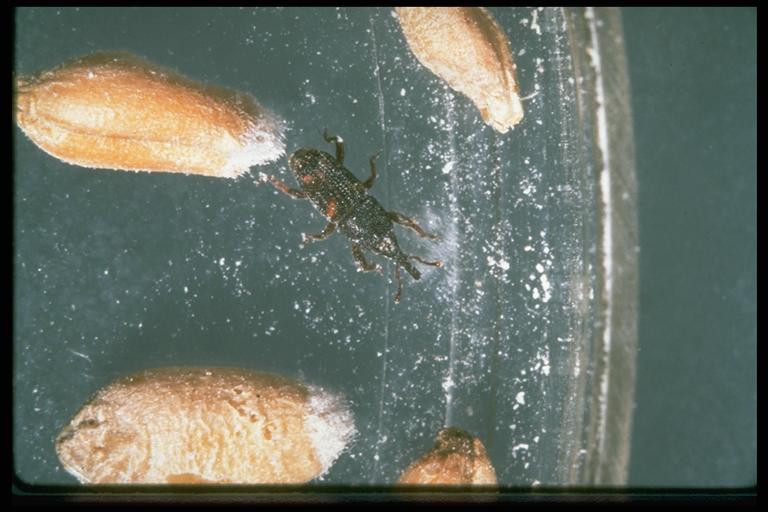
Rice weevil, Sitophilus oryzae (Linnaeus) (Coleoptera: Curculionidae). Photo by H. A. Turney.
Common Name: Rice weevil
Scientific Name: Sitophilus oryzae (Linnaeus)
Order: Coleoptera
Description: Adults are about 1/8 inch long, reddish brown to black with four reddish or yellowish spots on the wing covers (elytra). The head bears a slender snout and the shield behind the head (pronotum) has course round punctures. The elytra have deep lines (striae) and course punctures. Larvae are legless, white and rotund with a distinct head capsule.
The granary weevil, Sitophilus granarius (Linnaeus), and the maize weevil, Sitophilus zeamais Motschulsky, are other Curculionidae species that also occur in stored food products. The granary weevil has elongated punctures on the pronotum and is wingless.
Life Cycle: Adults are good fliers and easily disperse. Adults chew into the grain kernels from the outside and also to lay eggs. Females can lay 300 to 400 eggs typically one per cavity. Larvae develop through several stages (instars) inside the grain kernels and also pupate inside the kernel. They may complete a generation in a month in warm conditions. Adults often live for 7 to 8 months and some records are over 2 years.
Habitat and Food Source(s): Mouthparts are for chewing. Found in stored grains of all types including wheat, corn, oats, barley, sorghum, macaroni, and other grain products. They may also infest grain in the field. Larvae hollow out kernels of grain and usually attack whole kernels. Holes in the side of the grain are made by adults and by the emerging adults. They build up in numbers in stored grain.
Pest Status: Rice weevil is a cosmopolitan pest in stored grain products; medically harmless.
For additional information, contact your local Texas A&M AgriLife Extension Service agent or search for other state Extension offices.
Literature: Metcalf et al. 1962; Swan & Papp 1972.